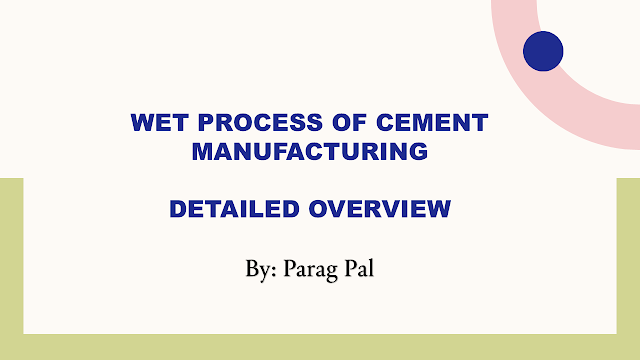Introduction
The wet process of cement manufacturing is one of the most traditional methods used in cement production. Despite being energy-intensive, it remains popular for certain types of raw materials that contain moisture. This article provides a comprehensive guide to the wet process, including its key steps, chemical reactions, advantages, and disadvantages.
What is the Wet Process of Cement Manufacturing?
The wet process involves mixing raw materials like limestone, clay, and sand with water to create a slurry. This slurry is then subjected to various steps like grinding, heating, and cooling, eventually forming the final cement product. The inclusion of water ensures better homogeneity, making the wet process ideal for specific raw materials.
Key Steps in the Wet Process
1. Extraction of Raw Materials
- Main Materials: The primary raw materials required for cement production are limestone, clay, and sand.
- Quarrying: The raw materials are extracted from natural quarries, which are open pits dug into the earth.
- Crushing: The extracted raw materials are then crushed to reduce their size. This ensures that they can be easily mixed and ground in later stages.
2. Mixing and Blending
- Slurry Formation: Once the raw materials are crushed, they are mixed with water to create a slurry. The slurry’s consistency is crucial for the rest of the process.
- Uniform Chemical Composition: The slurry helps in achieving a uniform chemical composition, ensuring that the final cement product is consistent in quality.
3. Grinding
- Equipment Used: The slurry is finely ground using ball mills or tube mills.
- Fineness Importance: Achieving the desired fineness is crucial, as it ensures thorough mixing and uniformity in texture. The finer the material, the easier it is for chemical reactions to take place later in the process.
4. Heating
- Kiln Process: The slurry is then fed into a rotary kiln, where it undergoes intense heating.
- Temperature: The kiln temperature reaches up to around 1450°C. This extreme heat is necessary for breaking down and forming essential chemical compounds.
5. Kiln Reactions
- Calcination: As the temperature increases, the slurry goes through a process called calcination, where calcium carbonate (CaCO3) decomposes into calcium oxide (CaO) and releases carbon dioxide (CO2).
- Clinkering: Following calcination, the material undergoes a phase called clinkering, where clinker nodules (small, hard lumps) are formed. The major compounds formed during clinkering are calcium silicates and calcium aluminates, which are key to cement’s binding properties.
6. Cooling
- Rapid Cooling: After clinkering, the hot clinker is rapidly cooled to preserve its desired mineral structure. This cooling helps in solidifying the formation of key compounds that give cement its strength.
7. Grinding of Clinker
- Addition of Gypsum: The cooled clinker is mixed with a small amount of gypsum to control the setting time of the cement.
- Final Grinding: This mixture is then finely ground into a powder to form the final cement product.
Advantages of the Wet Process
- Improved Chemical Composition: The wet process allows for better mixing and blending of raw materials, ensuring a uniform and consistent chemical composition. This leads to higher quality cement.
- Easier Handling: Slurry, being a liquid, is easier to handle and transport within the production process. The consistency of the slurry can also be controlled more efficiently, ensuring smooth operation.
- Suitable for Moisture-Rich Raw Materials: The wet process is ideal for raw materials that have a high moisture content. This eliminates the need for pre-drying, which is required in the dry process of cement manufacturing.
Disadvantages of the Wet Process
- Higher Energy Consumption: One of the main drawbacks of the wet process is its higher energy requirement. Since the slurry contains water, a significant amount of energy is consumed to evaporate the water during the heating process. This leads to higher production costs.
- Expensive Production: Due to the high energy demand, the wet process is more expensive than other methods like the dry process.
- Environmental Concerns: The wet process is associated with a larger carbon footprint due to its high fuel consumption. Additionally, the need for evaporating water makes the process less environmentally friendly.
Applications of the Wet Process
The wet process of cement manufacturing is particularly suitable for situations where the raw materials contain high moisture levels, and drying them before use would be impractical or expensive. It is also favored in regions where consistent quality and homogeneity of cement are critical.
Conclusion
The wet process of cement manufacturing, despite being energy-intensive, offers specific advantages that make it suitable for certain types of raw materials. Its ability to produce cement with uniform chemical composition is unmatched. However, the high energy and cost requirements, along with environmental considerations, mean that the wet process is gradually being replaced by more energy-efficient methods like the dry process.
Summary
Key Steps in the Wet Process:
Extraction of Raw Materials:
- Limestone, clay, and sand are extracted from quarries.
- Materials are crushed to reduce size.
Mixing and Blending:
- Crushed materials mixed with water to form a slurry.
- Slurry helps achieve uniform chemical composition.
Grinding:
- Slurry is ground using ball or tube mills.
- Ensures fine texture and thorough mixing.
Heating:
- Slurry is fed into a rotary kiln, heated to 1450°C.
- Undergoes calcination and clinkering reactions.
Cooling:
- Clinker is rapidly cooled to preserve mineral structure.
Grinding of Clinker:
- Clinker is mixed with gypsum.
- Ground into cement powder.
Advantages:
- Improved Chemical Composition: Better mixing and blending ensure uniform chemical composition.
- Easier to Handle: Slurry is easier to handle and control.
- Suitable for High-Moisture Raw Materials: Ideal for raw materials with high moisture content.
Disadvantages:
- Higher Energy Consumption: Significant energy is required for evaporating water.
- More Expensive: Higher production costs compared to the dry process.
- Environmental Concerns: Larger carbon footprint due to high fuel consumption.
Applications:
- Moisture-Rich Raw Materials: Especially suitable when raw materials contain high levels of moisture.









0 Comments